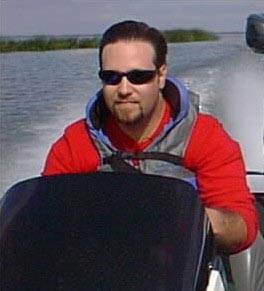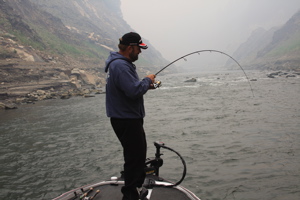 While the northern California foothill town of Oroville is known for its recreational use lake that hovers above the residents like a watchful benefactor, that is not all that the town has to offer. For residents, there are a plethora of restaurants, two Indian Casinos, plenty of hotels and a significant retail presence.
While the northern California foothill town of Oroville is known for its recreational use lake that hovers above the residents like a watchful benefactor, that is not all that the town has to offer. For residents, there are a plethora of restaurants, two Indian Casinos, plenty of hotels and a significant retail presence.
For the angler, there is always the popular attraction of Lake Oroville, and the Feather River, but if someone stops their thought process at those two fisheries, they are missing a true jewel in the Thermalito Afterbay. Local pro, Dave Rush, of nearby Palermo, Calif. knows how valuable all of the bass fisheries in his area are, and on one late summer day, decided to show them off.
With its ample vertical canyon walls, submerged humps and river channels, Lake Oroville is one of the premier spotted bass fisheries in the state. However, it shares close proximity to a tremendous largemouth fishery that would remind a bass angler of a world class body of water. The Thermalito Afterbay is a relatively shallow, weedy waterway reminiscent of Clear Lake, the California Delta, or some of the south’s most well known bass lakes.
Rush has been competing in tournaments since he was a teenager, and having spent parts of three decades beating heads against the best in the west; he has earned his stripes. Those badges include several victories in pro am competition throughout the west, more than one Angler of the Year title, a trip to the Red Man All American (now BFL All American) and a multitude of team tournament wins and titles to go with them.
 Photo - Dan O'Sullivan
|
With his knowledge of his home lake as a reason, Rush has earned a reputation as a spotted bass specialist. While he is extremely adept with a finesse rods in his hands chasing big spotted bass offshore, he is equally adept at targeting largemouth with a big stick in shallow water. He would prove just how versatile his skill set is on this smoky summer day.
The day’s itinerary was to probe the North Fork area of the lake for Oroville’s plentiful spotted bass population for the first half of the day, then head to the Afterbay following lunch to try and coax healthy bucketmouths from the weeds with power techniques.
Lake Oroville
As the summer fires ravaged much of Northern California, the skies above Lake Oroville appeared to have a heavy marine layer blanketing the entire area. However, instead of the cool temperatures and salty aroma that characterize the coastal influx, the stench of burning forest filled the air as the smoke burned the eyes and lungs of the anglers.
Rush launched his Triton Tr21X at the Spillway Ramp and piloted through the slot before bearing right into the North Fork of the Feather River; all the way fighting to see through smoke that was as thick as a run on an early fall morning in the Delta. While the trees burned only a few miles away from where he planned to fish, conditions were less than ideal for humans, but more than comfortable for Oroville’s spots. Even though the timbers were smoldering, it was the spotted bass fishing on Oroville that was on fire.
Using the Power of his Mercury ProXS 250, Rush pushed his boat further up the North Fork, eventually finding a resting place in the running water pouring down river.
He started by reaching for a Powell 702MLEF rigged with a Shimano Stella spinning reel and six-pound test PLine fluorocarbon, a homemade darterhead and six-inch Roboworm. Using his Minn Kota Max Pro 101 to fight the current, Rush fan casted the area producing several spotted bass. While the majority of the fish were just solid keepers, he managed to coax a few that weighed as much as two pounds to strike. “What I’m trying to do is allow the fish to tell me where the better ones are positioning themselves,” Rush said as he started rigging a second rod to use in the area. “I started inside the heavy current because it is as far as they could go, but as I work my way out, I’ll find the areas they’re holding in.” It was that second rod that produced the better fish.
The other weapon of choice was a Powell 754 CB glass which carried a Shimano Chronarch 100 MG spooled with 15-pound test PLine. On the business end of the setup initially was a Reaction Innovations Vixen in Rainbow Trout pattern that would be interchanged throughout the day with a Heddon Super Spook in Okie Shad and a River2Sea Rover 128 in Chartreuse Shad.
As he would feel the urge, Rush would pick up one of the topwater walking baits and hit specific areas along the bluff walls. It wasn’t long before he had begun to put together an extremely productive pattern for quality spotted bass. “Each strike has come as the bait has gotten really close to the walls,” Rush remarked. “These fish are really aggressive, and when they see something in their strike zone, they hammer it.”
His approach was to simply cover a lot of water trying to keep the baits in close proximity to the rocks; which he did until 11:30 AM. The game plan produced more than 75 keeper spotted bass and a few cracked or broken topwater baits from casting tight to the boulders at water’s edge.
Those shattered baits were deemed a necessary offering, as he ended the morning session with a solid 12-pound limit, including a pair of fish that hovered around the three pound mark; one just eclipsing it, and one crowding it cozily. Rush remarked that the total would have challenged for most of the team tournaments being held on the lake at that time, “This was as productive a pattern as I’ve seen in a while, and the fact that it was mainly on topwater, made it all the more enjoyable.”
Had he continued for the rest of the day, he would have likely tangled with more than 150 of Oroville’s spotted bass inhabitants; however, the Afterbay, and lunch at Rush’s favorite Mexican eatery beckoned.
The Thermalito Afterbay
Following a hair-raising meal that consisted of Carne Asada and copious amounts of chips and salsa, Rush climbed back into his Excursion and drove the five or so miles to the Afterbay where he once again launched his Triton into the water.
The Thermalito Afterbay is contained by rip-rap levees on one side and bordered by foothill lowland rolling hills that create several flats, coves and creek channel pockets. Those features combine with tules; cat tails aquatic weeds and shoreline grass to create a shallow water angler’s fantasy. Rush said that he has enjoyed many summer days of frog fishing on the Afterbay.
“I want to head around the corner into some of those pockets with standalone tule clumps,” Rush revealed. “I’m planning on pitching Senkos and throwing buzzbaits around the edges, and pitching frogs into the cover.” Rush rigged a Shimano Chronarch on a Powell 735MH with 65 pound PLine braid and River2Sea Bully Wa 65, he put the Senko on a 733CEF and 15-pound PLine with the same reel. The buzzbait, an old Tournament Lures Weapon, was tied onto the 754 CB glass with the same reel and 15-pound copolymer.
His first stop, in a cove near the takeoff produced no action, but when he made a run to the opposite end of the Afterbay, and quickly fished down the bank into the back of a pocket, things changed. At the back of the pocket was a weed lined ditch with a laydown log stretching across the middle; Rush paused to pick up the buzzbait and make a few casts.
When he retrieved the bladed surface bait past a clump of weeds on the right hand bank, a huge fish boiled on the bait, but missed the lure. “Wow! That was a good one,” Rush exclaimed excitedly. “That thing was in the six to seven pound range; that would’ve been fun.”
He fished his way through the ditch and back out the opposite bank to the flat on the edge of the pocket while making alternating casts with the frog and buzzbait. When he reached the front edge of the flat, a second piece of wood featuring a stump and a laydown log extended off of the point came into view. He made a quartering cast across the cover when a three pound largemouth busted the buzzbait.
He landed the chunky largemouth then continued down the bank, still alternating between the frog and the buzzbait. He left the bank for an isolated patch of tules in the middle of the cove, when he made a cast with the frog; he caught his second three pounder, which bit on the outside edge of the tules.
He continued around the front of the cover, still throwing the frog, until he reached the sparse tules, where he once again threw the buzzbait. As he retrieved the lure a second large bass exploded on it, was hooked briefly before coming off in the first seconds of the fight. “Man,” he said in frustration. “They are not really taking the bait very well, but the two that missed it were good ones.”
He plied the shallow grass for a little while longer before turning to the rip-rap levees to throw crankbaits and shaky heads looking for fish actively feeding around the outgoing current around the spillways. When nothing bit after a little more than an hour, he decided to head towards the ramp at around 6:00 PM.
Having spent the four hour afternoon session looking for big bites, Rush felt that he had found something that obviously was capturing their attention, but not quite providing the final component to make them fully commit. “They were reacting to the surface baits, but not taking it very well,” Rush said. “The one buzzbait fish I landed was hooked on the trailer hook, and the frog fish only had one hook in it; but that’s the way things go sometimes. I think it would get better as the sun starts to go down, but we still saw some action.”
Recap
With two half day sessions on two separate bodies of water in the Oroville area, it was plain that on that day at least, the spotted bass at Oroville were more responsive than the largemouth at the Afterbay. His morning session on the lake produced tremendous action, where he caught spotted bass in flurries, ending his day with more than 75 keepers landed, and a limit worth a little more than 12 pounds.
The afternoon session on the Afterbay was an exact opposite from the morning. Rush made cast after cast looking for a response from the quality largemouth that inhabit the waters there. While the efforts did not produce the results he would have hoped for, there were certainly encouraging responses from which to build upon.
While known for its deep clear reservoir, the Oroville area certainly offers bass anglers plenty of ways to target fish in a variety of types of cover, using several different methods to trigger strikes; quite literally a Rush of Opportunity for bass anglers in Oroville.


 Advertising
Advertising